A new home, marriage and job had me longing for my old, comfy garden patch on the Maine coast. How to move it to this new life? My quest led me to a best friend and her lessons in moving plants, dancing with ladybugs and finding fresh strength.
I found Elizabeth outside, crouched over and scooping soil into plastic grocery bags with green leaves poking out the top. Petite and wearing a baseball cap, she worked deep in the yard behind her tall, stately brick Victorian house with black shutters in my new town.
I introduced myself as the freelance magazine writer here to interview her for a story about “How to Move a Garden.”
“Oh HI!” she said, smiling, brushing off dirt and pulling off her garden gloves to extend a hand.
“Well … Here they are!”
She motioned to dozens of plastic grocery bags full of soil and plants, flopping every which way. Bagged daylilies, Japanese painted fern, double-purple columbines and Cranesbill geraniums sat tucked in the shade behind the lilacs, next to the compost pile, awaiting their move to her new house in West Virginia. Each bag also held a plastic tag with the plant’s name and a few scoops of compost.
Elizabeth chuckled. “I’m just trying to squeeze in as much compost into these bags as I can. I worked hard on it. I can’t just leave it here!”
In that moment in the summer of 2006, I knew we could be friends.
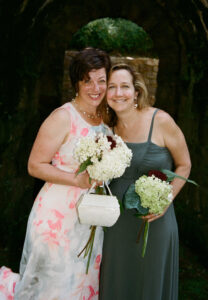
After walking beside each other through crises, Elizabeth stood for all my best friends as the Best Woman at my wedding.
Gardener’s Gold
The first time I’d left a garden behind, I moved my compost pile first. I’d shoveled the finished, rich soil — “gardener’s gold” we call it — from a spot near Maine’s Kennebec River into my red Toyota pickup truck, drove it eight miles inland and unloaded it onto a patch of grass that my new landlord had approved for a tiny garden. Next came my free-form hydrangea with its delicate ivory blossoms that bloom in late summer. That hydrangea then moved with me once more, and anchored the garden I’d left behind to move to central Pennsylvania. (Read more about hydrangea here.)
So I understood “I can’t just leave it here!” about something you made and nurtured over the years on a little patch of earth you’ve tended and loved. That longing had landed me here, in Elizabeth’s garden.
Elizabeth had already moved blueberry bushes and grapevine cuttings along with rhubarb, strawberry and raspberry plants to the new house. Among the last to go would be a boxwood shrub passed down from her grandmother and already in the family 25 years.
Elizabeth and her husband, Bill, were in the midst of their third move in a few years. Each time, she had packed and re-planted more than 500 daylilies and many more perennials. She’d opened her gardens for the local garden tour, earning the awe and respect of the garden club ladies in town who steered me to her when I asked for their help with a magazine feature on how to move a garden.
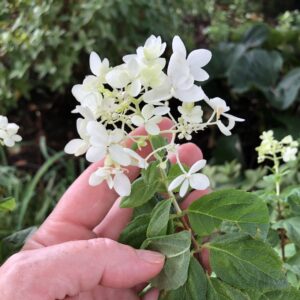
One tough and tender hydrangea has survived four moves to new gardens.
Uprooting
We garden folks like to think that life revolves around our gardens, and we’re probably happiest when it does. But the reality is that we are sometimes forced to uproot ourselves, leaving our gardens behind.
After pouring your heart and soul into a patch of earth for years, how do we leave it?
That was the premise of the story pitch, anyway. But truth be told, I was grieving more than a garden. I was grieving my old life in Maine, struggling here in a whole new life to find some footing, and connection.
I was 36 when I met Elizabeth. The previous summer, I’d had a gorgeous wedding on a sandy beach near Acadia National Park, then days later followed my new husband to graduate school at Penn State. I’d bought an adorable, folk Victorian house for us in Bellefonte, Pa., a town nestled among the mountain ridges and 20 minutes from campus.
Oh — and launched a freelance writing career after 13 years of “regular” jobs on the editorial staff of several publications.
You read right: New marriage, new job, and new-to-us house in a new state. And we made all those moves in a head-spinning, two-week period.
A year later, I was floundering. Way deep down, a little part of me knew this marriage and move was somehow both inevitable and not built on the true, everlasting, mature, to-the-end-of-the-earth kind of love.
The marriage was likely already in trouble. I craved the sea, felt stuck and trapped by these mountain ridges in a land-locked place.
When I left Maine, my writing niche was reporting and telling stories of all the incredible magic, life and conflict found in marine ecosystems. Here I was, in a new place with no mighty river, no harbors or fishing fleets. No briny marshes. No oyster farms, pounding surf, islands, tidal pools or coastline. And it is humid and hot here, without a cooling sea breeze off the water.
I was trying hard not to be miserable — so I focused on making a new garden, and making a new life.
A patch of weedy earth beckoned: The skinny, deep lot sloping down the hillside behind our tall and narrow house. I decided to dig into some garden writing, starting with a pitch on moving a garden.
That summer day, Elizabeth was plenty busy — and generous and gracious with her time, showing me all of her gardens: the lush bed of tall and arching ostrich ferns off the porch, curving beds of colorful perennials in full bloom, the tiered side garden full of herbs. Formal plantings in the front of the 1883 brick Victorian: Hostas, boxwood and blue mist bush lined the front walk. Two Peegee hydrangeas and a weeping cherry tree stood sentry near the sidewalk.
For the new owners, Elizabeth carefully left behind tidy plantings, a landscape map and plant list to serve as a starter garden for an inexperienced gardener.
Then she was gone.
Fresh Roots
Meanwhile, I’d begun to root in our little town. The garden club ladies and I were working hard to create a community children’s garden, to teach children about the natural world and nurture their sense of wonder.
On a garden tour day, Elizabeth arrived out of the blue with bags of extra daylilies to sell and a sign to help raise money for the project. She had been miserable in the new place and convinced her husband to return to our small town.
Soon, she agreed to help design a section of the children’s garden for birds and butterflies.
By then, I’d let go of the garden in Maine and the magical thinking that I could manage the property, and tend the garden from five states away. We sold the old, multi-family house. Before closing, following Elizabeth’s advice, I returned for the hydrangea and irises that had traveled and grown with me by then at three different houses along the Kennebec River, and left behind tidy, mulched beds for new owners.
Long drive for a few plants. But they reminded me of the musical clanging of the river’s buoy bells guiding boaters and delighting me as I worked the soil. They reminded me of how it felt to be part of a place.
Roaming & Rescuing
Elizabeth settled into a new-to-her, old brick Victorian house a 10-minute walk from mine. Soon, we were walking together a few mornings a week, telling stories and talking about everything from gardens to old houses to husbands and living a creative life. Elizabeth designs and makes botanical jewelry, capturing dogwood blossoms, oak leaves, hydrangea blossoms and leaves in sterling silver.
She would hit pause on my power-walking and talking to stoop and pick up a beautiful leaf or seed pod that had caught her eye. If not for her, I would never have noticed such tiny details.
We became a dangerous pair. We up-cycled, before it was cool and trendy. Both of us loved to save old items tossed to the curb and could not drive by a good, old wooden door, because if you love old houses — well, you just never know when you’ll need one.
We each had a pickup truck. Her husband also had a key to the town yard waste depot. We’d run off to snatch up plants people had given up on and tossed away, and loads of half-composted leaves for making new garden beds — because we are always making new garden beds.
We became good friends.
Ladybugs on the Loose
By then, I was fully rooted here in central Pennsylvania, in love with the land, the fertile soils and resilient forests, immersed in sustaining the children’s garden.
One July, we had a ladybug lesson coming up in the children’s garden and needed some actual ladybugs. So I mail-ordered thousands of ladybugs — maybe 10,000? — because that’s the smallest number I could find. The plan was to divvy them up into small batches and sell those to local gardeners.
On a wicked hot Saturday afternoon, Elizabeth came over with her scale and some small paper bags to help.
The lady at the ladybug place said to put them in the refrigerator crisper drawer and they would get really mellow and hibernate.
Then, I could measure them out by weight into individual packets. I carefully calculated the number of ounces for each bag.
But when we pulled the ladybugs from the crisper drawer into the hot kitchen, they all perked up really fast.
And all at once. I froze, stuck on how we were going to herd them all onto the scale and into bags as they were crawling off in all directions.
Elizabeth took charge. In one sweep of her arm on the kitchen counter, she loaded all the ladybugs into one bag, ran with it out to the kitchen porch, shook them out into several bags, clipped them at the top with clothespins and put them all back in the crisper drawer.
It took her about a minute.
Then we laughed, shrieked and doubled over with laughter. Then giggled some more.
That winter, every so often I’d spot a ladybug crawling up the sage green walls of the kitchen and text Elizabeth: Hey, Elizabeth! You missed one!
Hunker Down, Girl
Building a life here, I was immersed, too, in turning the narrow, sloping hillside behind my house into a luscious, sun-dappled shade garden below a canopy of maple trees. My garden was a vast space to tend by hand and I lost myself in hauling rocks and logs to make level paths, in moving truckloads of mulch and wood chips down onto the hillside, one wheelbarrow at a time.
Just in time. Soon, the new friendship and garden woven into my safety net would be tested.
My marriage was strained. We kept trying new marriage counselors. None could fix that despite the love we’d felt for one another, it was not the kind that could go the distance. We weren’t in love, nor were we the right people for each other. My closest friends, like Elizabeth, knew long before I did and were ready to catch me.
When my then-husband got a one-year teaching assignment six hours away, I stayed behind. My intuition insisted I hunker down. That little voice inside was loudest when I was digging in the shade garden behind our house. An earlier, younger, more naïve version of me had ignored the warnings of my intuition, so perhaps this time it was shouting loud enough to hear.
My ex-husband and I separated that fall, and Elizabeth took care of me the whole time, sharing walks and dinners, zipping over when I needed help moving a piece of furniture, reclaiming the house as solely my space, one room at a time — making sure that as I cried my necessary tears through the winter, that I kept moving and did not get lost or stuck in the depths of grief over the marriage.
Spring Always Comes
Spring arrived, without fail. I felt better. I was mending, healing and traveling again on magazine assignments. On one flight, I sat beside an angel who shared wisdom on relationships and marriage. That pep talk from Pheonix to Minneapolis helped me forgive myself.
I took a train trip to Boston for a writing conference and visit with a good friend, soothed for 12 hours each way listening to the rhythm of the steel wheels clattering on the tracks and the train’s swaying, forward motion.
On the return trip, Elizabeth texted. She felt a lump in her breast. I am nauseous now as I write, recalling that message, when my stomach dropped to my knees. At the time, her husband commuted to an out-of-town job during the week and came home on weekends.
I remembered a chilling statement she’d made the previous Christmas. With her family history, she said, it was not a matter of if she would get breast cancer, but when. So she was sure, the instant she felt the lump.
She asked if I would go with her to the biopsy. Of course. And my muscle memory kicked in. During my dad’s life-threatening illness, I had chased doctors for information, becoming his advocate and bulldog, his “business manager,” as he said.
So I jumped in to be Elizabeth’s bulldog, traveling to appointments and taking notes and talking through everything she was learning. Off we went to meet with a breast surgeon, an oncologist, a plastic surgeon at the big medical facility two hours away.
We made a list of all the greenhouses between our town and the hospital and added plant shopping onto each trip. We bought loud, outrageous garden hats in bright turquoise, grass green and hot pink and wore them in the waiting room the morning of her double mastectomy.
She was a lesson in living and grit. She was a warrior.
She’d scheduled her surgery and chemo treatments around the big and intense, four-day Central Pennsylvania Festival of the Arts and just over a week after her surgery she did every long, hot day of that show.
In that next year, I could not fix her breast cancer, just walked beside her and did what I could to make it suck a little less, a bit less awful.
When she felt up to it, we walked in town. Sometimes on the path between woods and the creek. She helped me re-furnish my empty house, a piece at a time. Out with the old couch, in with the new — and in-between Elizabeth and her husband shared their couch so I wasn’t home alone through all the holidays that seemed meant for couples and families.
Quietly, we fought together for our survival; hers physical, mine emotional. We became sisters. We helped each other heal.
Best Woman, Ring-Maker — & Cheerleader
A few years later, Elizabeth’s cancer gone, she once again bagged up her most important plants for another move and I had a huge favor to ask. Would she be my best woman? And stand for me at my wedding, representing all of my best women friends?
Friends who could not be there because the wedding was in five days. I’d fallen head-over-heels in love with a good, kind, handsome man and his two teenage sons. We just knew. This was the right guy and the right love, built on the true, everlasting, mature, to-the-end-of-the-earth love.
The house was the “Man Cave,” but the property — flat and in full sun with mountain views — was a blank slate with room to play whiffle ball and grow tomatoes. Room for an end zone and my favorite pollinator plants. I’d started a garden, moved a lot of plants and knew I’d be saying goodbye to the shady hillside.
Mike and I had been waiting to see how deep into the playoffs my stepson’s All-Star team would play. The season ended and the next Saturday, lots of friends and family would soon gather for our summer picnic, so we decided it was a good time to get married.
Why not? Second weddings are pretty low-key — at least this one would be.
This was a big ask of Elizabeth, given the timing. She was plenty busy with a move to Maryland for her husband’s job. My wedding would take her whole Saturday on her final weekend in the house and garden she was leaving.
Oh, and would she make our rings?
But Elizabeth did not hesitate for a second. She was happy and excited and said yes, of course she could. She made a simple silver band for Mike and a band of hydrangea leaves linked with berries for me. We gathered buckets of hydrangea blooms from the garden she was about to leave for our bouquets and centerpieces.
When the pastor declared that Mike and I were married, Elizabeth pumped her fist. It’s one of my favorite wedding pictures.
“You hit the jackpot,” she always says, and she is right. I’d moved over a line of mountain ridges and an hour away from my friend and shade garden in that little Victorian town to be with my new family — and had never in my life been so sure of anything.
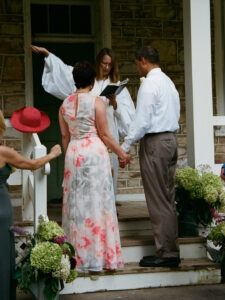 Early that Monday morning after the wedding, as Elizabeth packed for the last load of the move, I was at her soon-to-be-old house with coffee, helping her with the final cleaning and packing. How could I not?!
Early that Monday morning after the wedding, as Elizabeth packed for the last load of the move, I was at her soon-to-be-old house with coffee, helping her with the final cleaning and packing. How could I not?!
And when the house was done, we stuffed bagged and potted plants into every corner of her SUV, even the pockets of her capris before she drove away.
When Gardens End
The day we met, Elizabeth had answered all my initial questions about moving, what plants to take and what to leave, how to pack plants for the move, how to leave the garden for new people. Over 17 years, as I worked through all those bigger, deeper questions I could not ask her that day, she helped by walking beside me, inspiring strength as I worked out the answers. The best kind of friend.
But she never did literally answer the question of how one moves a garden. Perhaps because she does not believe, nor could not bring herself to say the words “You can’t.”
You can move plants, and tools, mulch and compost. You can move yourself, and all of your stuff and gear, your books, furniture, pots and pans. You can move your mindset, your heart and your philosophy, your memories, your love of community. You take lessons and wisdom, friendship and connection.
All that comes with you to the next place.
But you cannot move a whole garden.
A garden is a collaboration of soul, careful hand-tending and a unique patch of earth, so it cannot be moved.
That intimate connection and communion among your soul, your hands, the earth and natural world over time happens at that specific place and time. Like a performance after the singer has left the stage, the garden ends once the gardener leaves the place. Even if a new owner takes it on and tends it, your garden has ended and a new one that belongs to someone else has begun.
But you can say goodbye, beautifully.
New Adventures
So, before we closed on the sale of the sweet folk Victorian house, I thanked my shade garden on the hillside for helping to see me through the storm. Once again putting Elizabeth’s lessons to work, I potted up five small hydrangea seedlings, offshoots from the main plant that — just like me — used to grow and thrive in Maine, and found a way to grow and thrive in central Pennsylvania. I made a new garden, my last I expect, here in the full sun on the other side of the mountain ridges from Elizabeth.
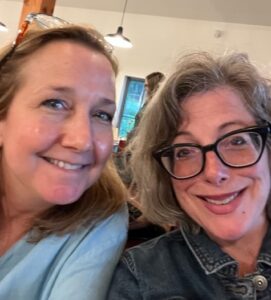
Elizabeth and I, out for dinner, in September 2022.
Three years after she stood as the best woman at my wedding, Elizabeth moved back to Bellefonte and created a lovely shop, “Art a la Carte” in an old downtown building. She sells gorgeous glassware, pottery, fiber, art, paintings, wood carvings, jewelry and silk — all made by Pennsylvania artists.
There is plenty of research linking solid friendships to health benefits like lower stress, better coping and better physiological functioning in daily life.
I can vouch for that. Like plants, even best friendships are difficult to sustain through moves and transitions. The stress can be too much. No longer is it easy to meet for a morning walk or pop over for a glass of wine on the porch. Many friendships fade away.
Ours has changed from when we lived in the same town, digging for cast-off plants and fighting alongside each other in the trenches through that year of my divorce and her breast cancer.
We have each come out the other side of our crises, both intact — and changed. Stronger. We don’t need each other as much as we did that year.
But we still love each other, and lean on each other. And so we are in constant contact and visit every few weeks.
Sometimes, friendship-for-life takes some grit, a commitment to have difficult, necessary and honest conversations. Some people can’t do that, and the friendship fades.
But, gratefully, Elizabeth and I can.
Ever notice how a plant will make its way through the tiniest crack in the concrete, always seeking the sun? That’s Elizabeth. She is as tough and tender as our most cherished plants. Me too.

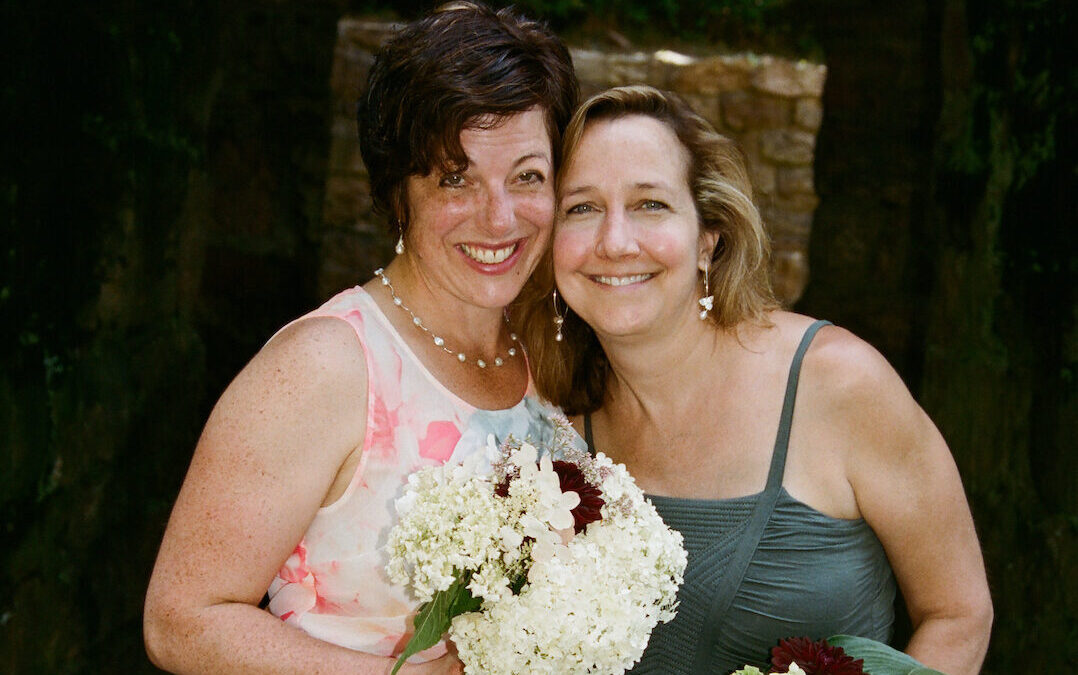
How soulfully beautiful and true… as one whose life is also blessed by friendship with Elizabeth Hay, I find so much delight in this tribute to her. She is remarkably “a mensch” in every way, and beautiful inside and outside, too… and the quality of her kinship is sweet as nectar!
Thank you Ann! You are so right. Elizabeth is absolutely beautiful inside and out. A treasure! We are lucky!
Oh what a friendship you have with Elizabeth, How wonderful! I have a great friendship with Donna who I have known since childhood. We live hours apart but still so close!
How fantastic, Beverly! Soooooo good for you and for Donna. The longer I live, the more I value connection. That’s what matters most! Beautiful 🙂
How beautiful your relationship/friends-for-life! I wish I had been better able to maintain at least one good friend throughout all of our moves from the mid-west to northern PA to the east coast and back into PA to settle first in State College and then in beautiful Bellefonte. I met Elizabeth via Art a la Carte, bringing in my watercolors for her to hang. And I found this fantastic woman with her fingers into so many wondrous things I can hardly keep track of! As a rather elderly artist, Elizabeth brings out the joy in sharing my work. She always comments on which one are her absolute favorite and she’s a great one for selling the works of all the artists in the shop!
Thanks for sharing this lovely story. It reminds me to call my oldest bestest friend, from whom I’ve been separated for some 58 years due to our separate paths and many moves in both of our lives. Thank you for reminding me of Mary Ellen!
PS I have 3 websites plus a Facebook page. Can’t remember any of them!
Thank you Pat! Your description of Elizabeth is spot-on. She has a wonderful eye, and is so talented at spotlighting what’s most beautiful and spreading and sharing the joy of it. Love your work. It’s almost impossible to maintain a best friendship at the same level through physical moves and over the distance. But … then, from the moment you are in touch, you are back in that nourishing connection and pick up right where you left off. Such a gift. Thank you for reading. Take good care of you & keep up the great work! Best, Lisa